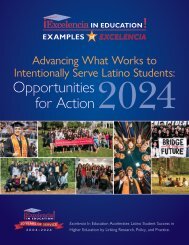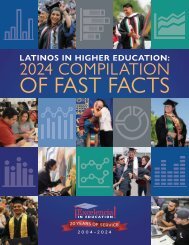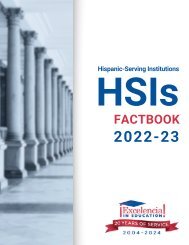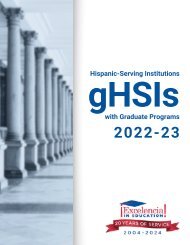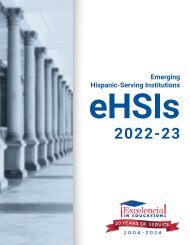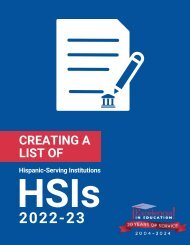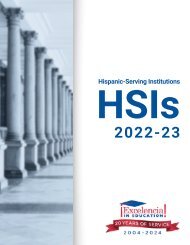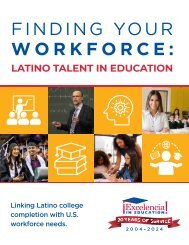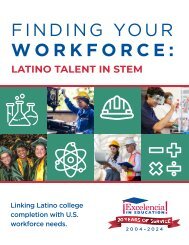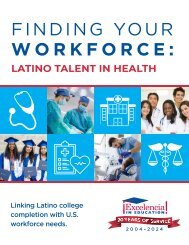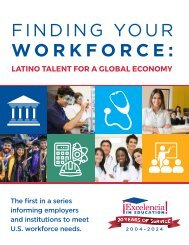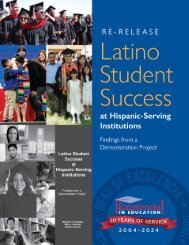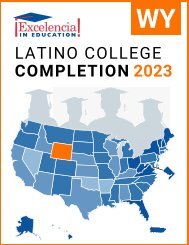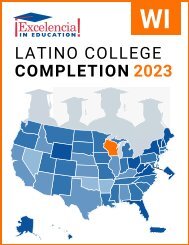Latino College Completion 2023: Tennessee
You also want an ePaper? Increase the reach of your titles
YUMPU automatically turns print PDFs into web optimized ePapers that Google loves.
TN
LATINO COLLEGE COMPLETION:<br />
TENNESSEE – <strong>2023</strong><br />
For the U.S. to regain the top ranking in the world for college degree<br />
attainment, <strong>Latino</strong>s will need to earn 6.2 million degrees by 2030. 1<br />
FAST FACTS<br />
STATE RANKING:<br />
<strong>Tennessee</strong> had the 26th largest<br />
<strong>Latino</strong> population in the U.S.<br />
K-12 POPULATION:<br />
In <strong>Tennessee</strong>, 10% of the K-12<br />
population was <strong>Latino</strong>. 2<br />
POPULATION:<br />
In <strong>Tennessee</strong>, 6% of the population<br />
was <strong>Latino</strong>. 2<br />
MEDIAN AGE:<br />
The median age<br />
of Hispanics<br />
in <strong>Tennessee</strong> was<br />
25, compared<br />
to 42 for White<br />
non-Hispanics. 2<br />
25<br />
Hispanics<br />
42<br />
White<br />
non-Hispanics<br />
ENROLLMENT:<br />
In <strong>Tennessee</strong>, 15% of Hispanics<br />
(ages 18 to 34) were enrolled in higher<br />
education, compared to 21% of<br />
White non-Hispanics. 2<br />
DEGREE ATTAINMENT:<br />
In <strong>Tennessee</strong>, 26% of Hispanic<br />
adults (25 and older) had earned an<br />
associate degree or higher, compared to<br />
40% of White non-Hispanic adults. 2<br />
Hispanic Adults = 2.6 of 10<br />
To reach the degree attainment goal by 2030, the U.S. can: close<br />
the degree completion gap by accelerating <strong>Latino</strong> completion while<br />
increasing for all students and scale up programs and initiatives that<br />
work for <strong>Latino</strong>, and all, students. The following demographics,<br />
institutional data, and practices inform <strong>Latino</strong> degree attainment.<br />
ENROLLING: Top 5 Institutions (Hispanic Undergraduates) in <strong>Tennessee</strong>, 2021-22<br />
Institution<br />
Sector<br />
Grand<br />
Total<br />
NOTE: We use the terms <strong>Latino</strong> and Hispanic interchangeably in this factsheet.<br />
Hispanic<br />
Total<br />
Source: Excelencia in Education analysis using U.S. Department of Education, National Center for<br />
Education Statistics (NCES), Integrated Postsecondary Education Data System (IPEDS), 2021 Fall<br />
Enrollment, Graduation Rates Survey and Institutional Characteristics Survey.<br />
%<br />
Hispanic<br />
1 Middle <strong>Tennessee</strong> State University Public, 4-year 17,713 1,412 8%<br />
2 The University of <strong>Tennessee</strong>-Knoxville Public, 4-year 24,957 1,375 6%<br />
3 University of Memphis Public, 4-year 14,591 1,195 8%<br />
Private not-forprofit,<br />
4-year<br />
4 Vanderbilt University<br />
7,104 758 11%<br />
5 Austin Peay State University Public, 4-year 7,490 721 10%<br />
ASSOCIATE DEGREES: Top 5 Institutions Awarding to Hispanics in <strong>Tennessee</strong>, 2020-21<br />
Institution<br />
Sector<br />
Grand<br />
Total<br />
Hispanic<br />
Total<br />
%<br />
Hispanic<br />
1 Austin Peay State University Public, 4-year 1,301 133 10%<br />
2 Nashville State Community <strong>College</strong> Public, 2-year 1,025 101 10%<br />
3 Motlow State Community <strong>College</strong> Public, 2-year 1,112 96 9%<br />
4 Pellissippi State Community <strong>College</strong> Public, 2-year 1,599 88 6%<br />
5 Volunteer State Community <strong>College</strong> Public, 2-year 1,243 80 6%<br />
BACHELOR DEGREES: Top 5 Institutions Awarding to Hispanics in <strong>Tennessee</strong>, 2020-21<br />
Institution<br />
Sector<br />
Grand<br />
Total<br />
Hispanic<br />
Total<br />
%<br />
Hispanic<br />
1 Middle <strong>Tennessee</strong> State University Public, 4-year 3,916 238 6%<br />
2 The University of <strong>Tennessee</strong>-Knoxville Public, 4-year 5,170 214 4%<br />
3 University of Memphis Public, 4-year 3,152 171 5%<br />
Private not-forprofit,<br />
4-year<br />
4 Vanderbilt University<br />
1,712 167 10%<br />
Private not-forprofit,<br />
4-year<br />
5 Belmont University<br />
1,536 109 7%<br />
White Adults = 4.0 of 10<br />
1 Projections to 2030: Excelencia in Education. (2020). Ensuring America’s Future: Benchmarking <strong>Latino</strong><br />
<strong>College</strong> <strong>Completion</strong> to 2030. Excelencia in Education. Washington, D.C.<br />
2 U.S. Census Bureau, 2021 American Community Survey 1-Year Estimates
<strong>Tennessee</strong> Gap in Degree <strong>Completion</strong><br />
Closing the degree completion gap can be tracked<br />
by the 4 measures shown below. Alone, none<br />
of these measures capture the entire “story” of<br />
degree completion. However, in combination,<br />
they provide a useful picture of the gap in degree<br />
attainment between Hispanic and White non-<br />
Hispanic cohorts in a single year.<br />
Graduation Rate — Total percentage of students<br />
who graduated within 150% of normal time for<br />
first-time, full-time freshmen. This incorporates<br />
students that graduated in 3 years at two-year<br />
institutions, or in 6 years at four-year institutions.<br />
Transferred to Another Institution —<br />
Percentage of students that transferred to another<br />
institution and did not complete a degree.<br />
Still Enrolled — Percentage of students that are<br />
still enrolled at the point of 150% normal time to<br />
completion.<br />
No Longer Enrolled — Percentage of students<br />
that are no longer enrolled at the point of 150%<br />
normal time to completion.<br />
At two-year institutions, Hispanics’<br />
graduation rate was 1%-point<br />
lower than that of their White<br />
non-Hispanic peers in <strong>Tennessee</strong>.<br />
TWO-YEAR INSTITUTIONS<br />
54%<br />
32%<br />
WHITE<br />
55%<br />
6% 8%<br />
8%<br />
7%<br />
-1%<br />
31%<br />
HISPANIC<br />
DEGREE OUTCOMES<br />
■ No Longer Enrolled<br />
■ Still Enrolled<br />
■ Transferred to<br />
Another Institution<br />
■ Graduation Rate<br />
*Percentages may not add up to 100% due to rounding.<br />
At four-year institutions, Hispanics’<br />
graduation rate was 5%-points<br />
lower than that of their White<br />
non-Hispanic peers in <strong>Tennessee</strong>.<br />
FOUR-YEAR INSTITUTIONS<br />
1%<br />
21%<br />
63%<br />
WHITE<br />
-5%<br />
25%<br />
58%<br />
HISPANIC<br />
NOTE: Outcomes shown are for students at two-year institutions who started in Fall 2018, and<br />
for students at four-year institutions who started in Fall 2015.<br />
Source: Excelencia in Education analysis using the U.S. Department of Education, National<br />
Center for Education Statistics (NCES), Integrated Postsecondary Education Data System, 2021<br />
Graduation Rates Survey and the Institutional Characteristics Survey.<br />
15%<br />
2%<br />
15%<br />
Examples of What Works for <strong>Latino</strong> Students<br />
There are institutions showing success in enrolling, retaining, and graduating <strong>Latino</strong> students. The following are examples of<br />
programs across the country with evidence of effectiveness in serving <strong>Latino</strong> students nominated for Examples of Excelencia.<br />
The YMCA <strong>Latino</strong> Achievers program inspires and empowers <strong>Latino</strong><br />
students to discover their strengths, shape their futures, and transform<br />
the world. <strong>Latino</strong> Achievers program uses evidence-based strategies to<br />
increase high school graduation, college application, and enrollment rates<br />
for <strong>Latino</strong> youth. They serve <strong>Latino</strong> high school students (ages 14-21) in<br />
nine public schools in Nashville’s metro schools. The <strong>Latino</strong> Achievers<br />
program serves schools that have two to seven times more <strong>Latino</strong><br />
youth than the state average of 9.0%, lower than average high school<br />
graduation rates, have lower than average ACT scores, and will graduate<br />
mostly first-generation college students. <strong>Latino</strong> Achievers was adopted<br />
by the YMCA of Middle <strong>Tennessee</strong> in 2002 to address low high school<br />
graduation rates and college matriculation rates of <strong>Latino</strong> students. Since<br />
then, the program has grown to serve nine schools, with students from<br />
18 area high schools attending workshops and field trips. <strong>Latino</strong> Achievers<br />
seeks to close the achievement gap for <strong>Latino</strong> students by using evidencebased<br />
practices to increase college application and enrollment rates for<br />
<strong>Latino</strong> students. These include: increasing exposure to college through<br />
tours and fairs, building skills including ACT preparation and financial aid<br />
planning, encouraging mentorship and providing individualized counseling,<br />
introducing professions through the world of work tours, and afterschool<br />
programming using a college readiness curriculum with a culturally<br />
responsive emphasis. <strong>Latino</strong> Achievers invites local <strong>Latino</strong> professionals to<br />
inspire and empower their students by sharing their experiences of being<br />
<strong>Latino</strong> in college and professional settings, both as guest speakers and<br />
in one-on-one meetings with students during their annual power lunch.<br />
In addition to continued participation with the program, students are<br />
encouraged to meet regularly with staff to receive additional support in<br />
their college application process. <strong>Latino</strong> Achievers also offers scholarships<br />
for their students, especially those who are ineligible for financial aid due<br />
to their residency status.<br />
For the 2017- 2018 academic year the graduation rate for the 51 active<br />
Latinx students was 100% compared to the district average of 74% and<br />
the national average of 79%. In addition, for the 2010-2011 academic year,<br />
93% of participants graduated high school. Of the 2017-2018 graduates,<br />
98% enrolled in college compared to 38% for the 2010-2011 graduates.<br />
For more information on institutional programs improving <strong>Latino</strong> student success in higher education, access Excelencia in<br />
Education’s Growing What Works database at http://www.edexcelencia.org/growing-what-works<br />
ENSURING AMERICA’S FUTURE BY INCREASING LATINO COLLEGE COMPLETION • WWW.EDEXCELENCIA.ORG




